YAMAHA TMAX 2018 Owners Manual
Manufacturer: YAMAHA, Model Year: 2018, Model line: TMAX, Model: YAMAHA TMAX 2018Pages: 122, PDF Size: 14.97 MB
Page 101 of 122
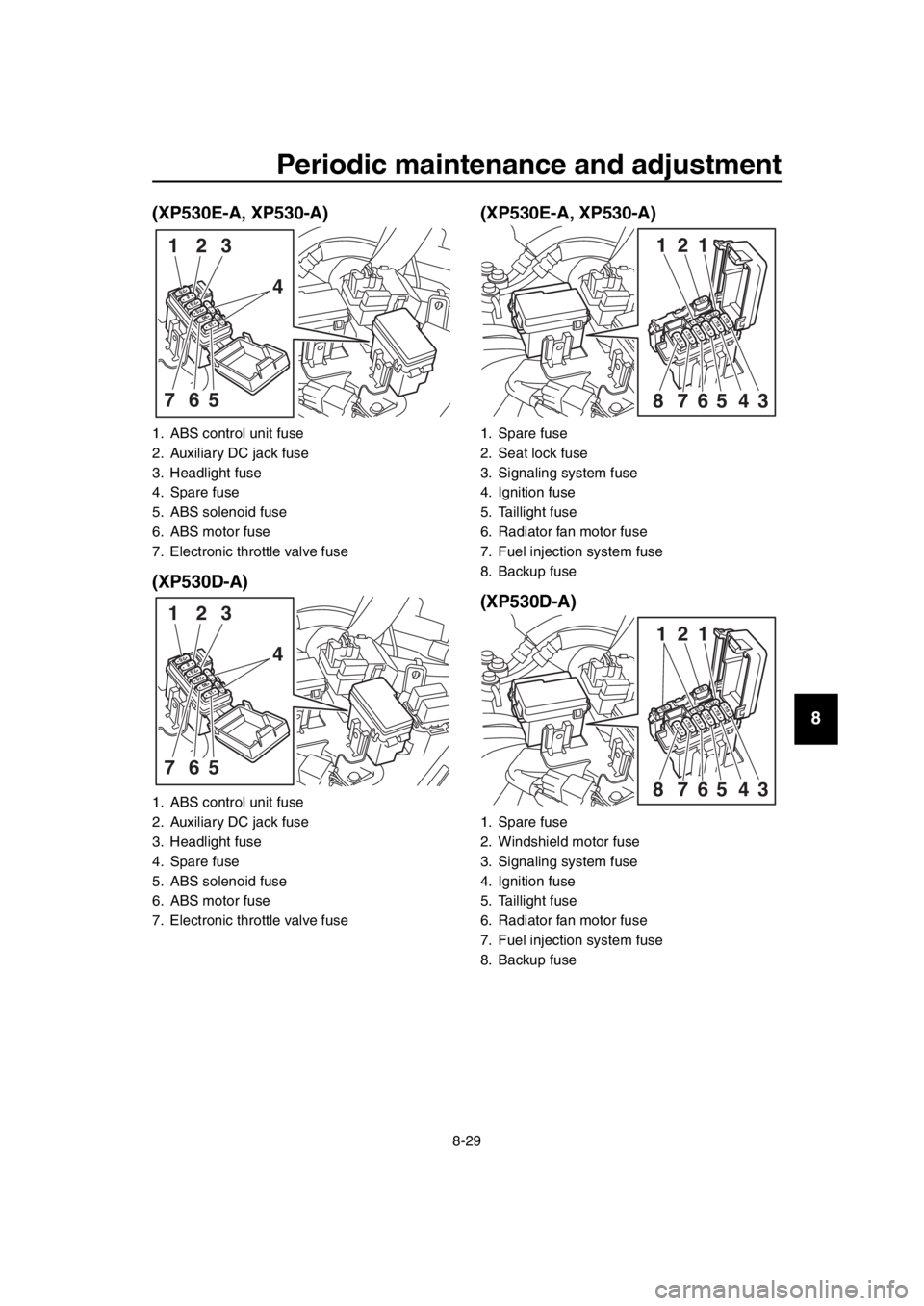
Periodic maintenance and adjustment
8-29
1
2
3
4
5
6
7
8
9
10
11
12
13
14
(XP530E-A, XP530-A)
(XP530D-A)
(XP530E-A, XP530-A)
(XP530D-A)
1. ABS control unit fuse
2. Auxiliary DC jack fuse
3. Headlight fuse
4. Spare fuse
5. ABS solenoid fuse
6. ABS motor fuse
7. Electronic throttle valve fuse
1. ABS control unit fuse
2. Auxiliary DC jack fuse
3. Headlight fuse
4. Spare fuse
5. ABS solenoid fuse
6. ABS motor fuse
7. Electronic throttle valve fuse
4
765 123
4
765 123
1. Spare fuse
2. Seat lock fuse
3. Signaling system fuse
4. Ignition fuse
5. Taillight fuse
6. Radiator fan motor fuse
7. Fuel injection system fuse
8. Backup fuse
1. Spare fuse
2. Windshield motor fuse
3. Signaling system fuse
4. Ignition fuse
5. Taillight fuse
6. Radiator fan motor fuse
7. Fuel injection system fuse
8. Backup fuse
1
34568
12
7
1
34568
12
7
UBV1E1_1.book 29 ページ 2018年4月27日 金曜日 午後4時41分
Page 102 of 122
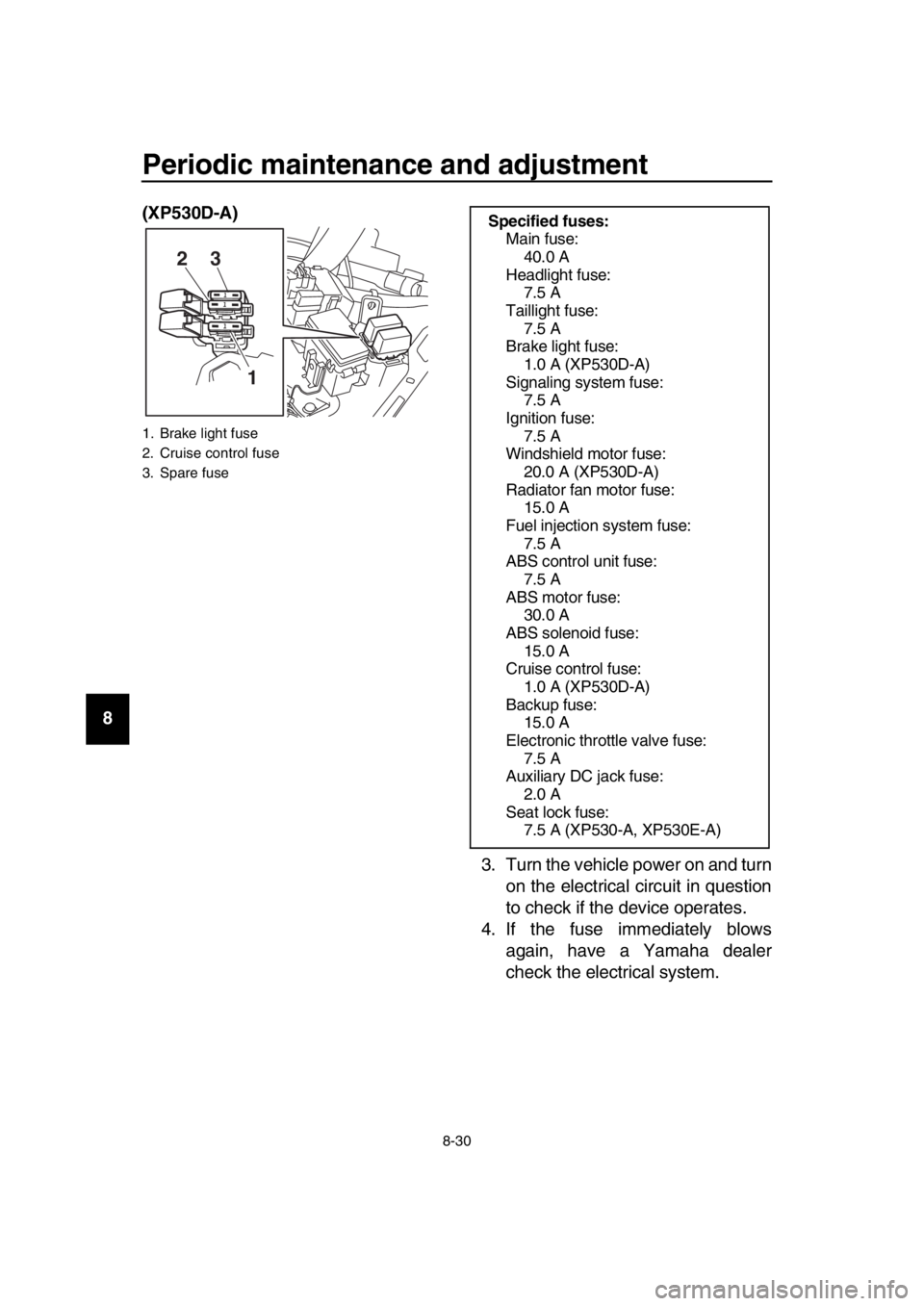
Periodic maintenance and adjustment
8-30
1
2
3
4
5
6
7
8
9
10
11
12
13
14 (XP530D-A)
3. Turn the vehicle power on and turnon the electrical circuit in question
to check if the device operates.
4. If the fuse immediately blows again, have a Yamaha dealer
check the electrical system.
1. Brake light fuse
2. Cruise control fuse
3. Spare fuse
3
1
2
Specified fuses:
Main fuse:
40.0 A
Headlight fuse: 7.5 A
Taillight fuse: 7.5 A
Brake light fuse:
1.0 A (XP530D-A)
Signaling system fuse: 7.5 A
Ignition fuse: 7.5 A
Windshield motor fuse:
20.0 A (XP530D-A)
Radiator fan motor fuse: 15.0 A
Fuel injection system fuse: 7.5 A
ABS control unit fuse:
7.5 A
ABS motor fuse: 30.0 A
ABS solenoid fuse:
15.0 A
Cruise control fuse: 1.0 A (XP530D-A)
Backup fuse: 15.0 A
Electronic throttle valve fuse:
7.5 A
Auxiliary DC jack fuse: 2.0 A
Seat lock fuse: 7.5 A (XP530-A, XP530E-A)
UBV1E1_1.book 30 ページ 2018年4月27日 金曜日 午後4時41分
Page 103 of 122
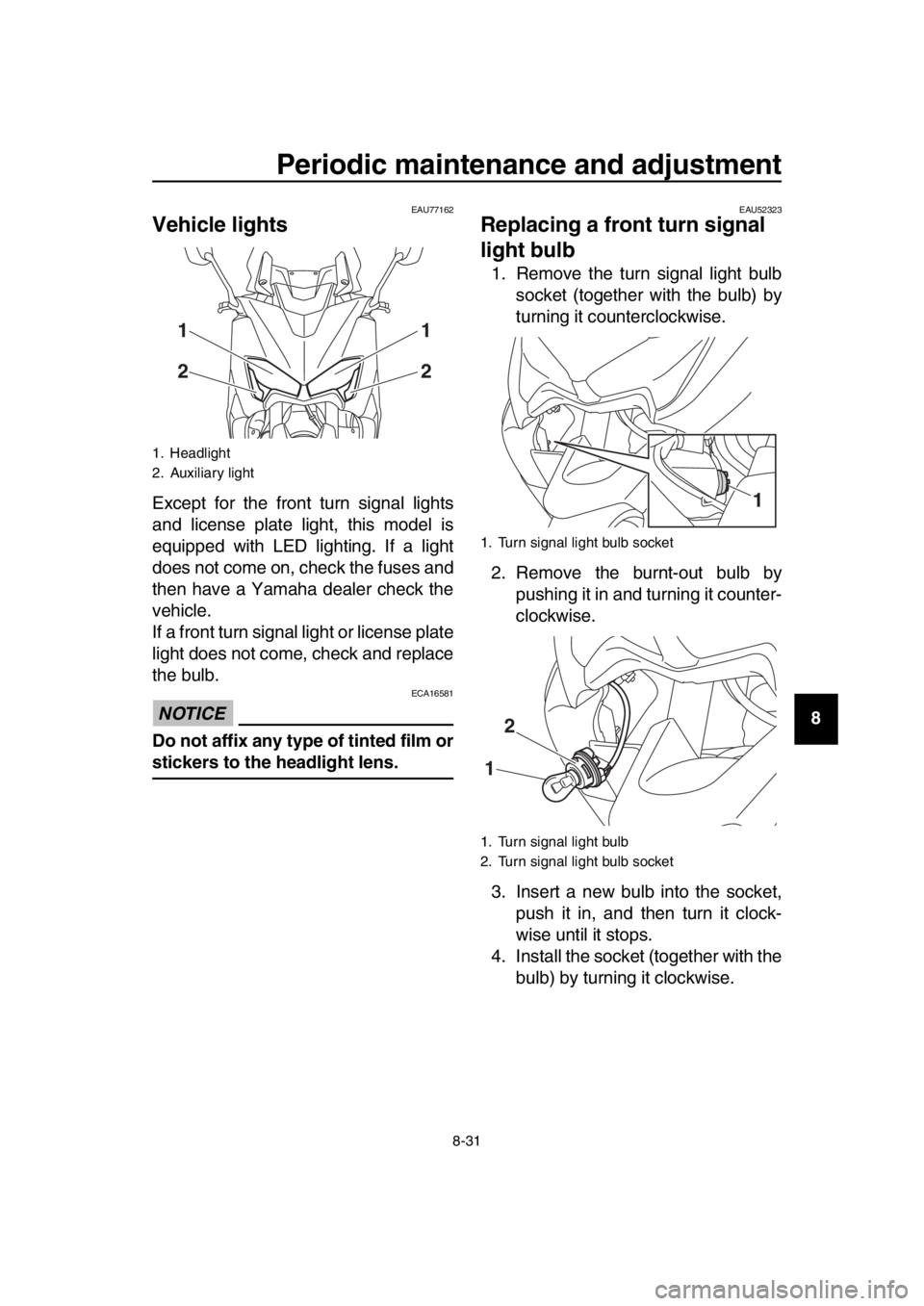
Periodic maintenance and adjustment
8-31
1
2
3
4
5
6
7
8
9
10
11
12
13
14
EAU77162
Vehicle lights
Except for the front turn signal lights
and license plate light, this model is
equipped with LED lighting. If a light
does not come on, check the fuses and
then have a Yamaha dealer check the
vehicle.
If a front turn signal light or license plate
light does not come, check and replace
the bulb.
NOTICE
ECA16581
Do not affix any type of tinted film or
stickers to the headlight lens.
EAU52323
Replacing a front turn signal
light bulb
1. Remove the turn signal light bulb socket (together with the bulb) by
turning it counterclockwise.
2. Remove the burnt-out bulb by pushing it in and turning it counter-
clockwise.
3. Insert a new bulb into the socket, push it in, and then turn it clock-
wise until it stops.
4. Install the socket (together with the bulb) by turning it clockwise.
1. Headlight
2. Auxiliary light
1
21
2
1. Turn signal light bulb socket
1. Turn signal light bulb
2. Turn signal light bulb socket
1
12
UBV1E1_1.book 31 ページ 2018年4月27日 金曜日 午後4時41分
Page 104 of 122
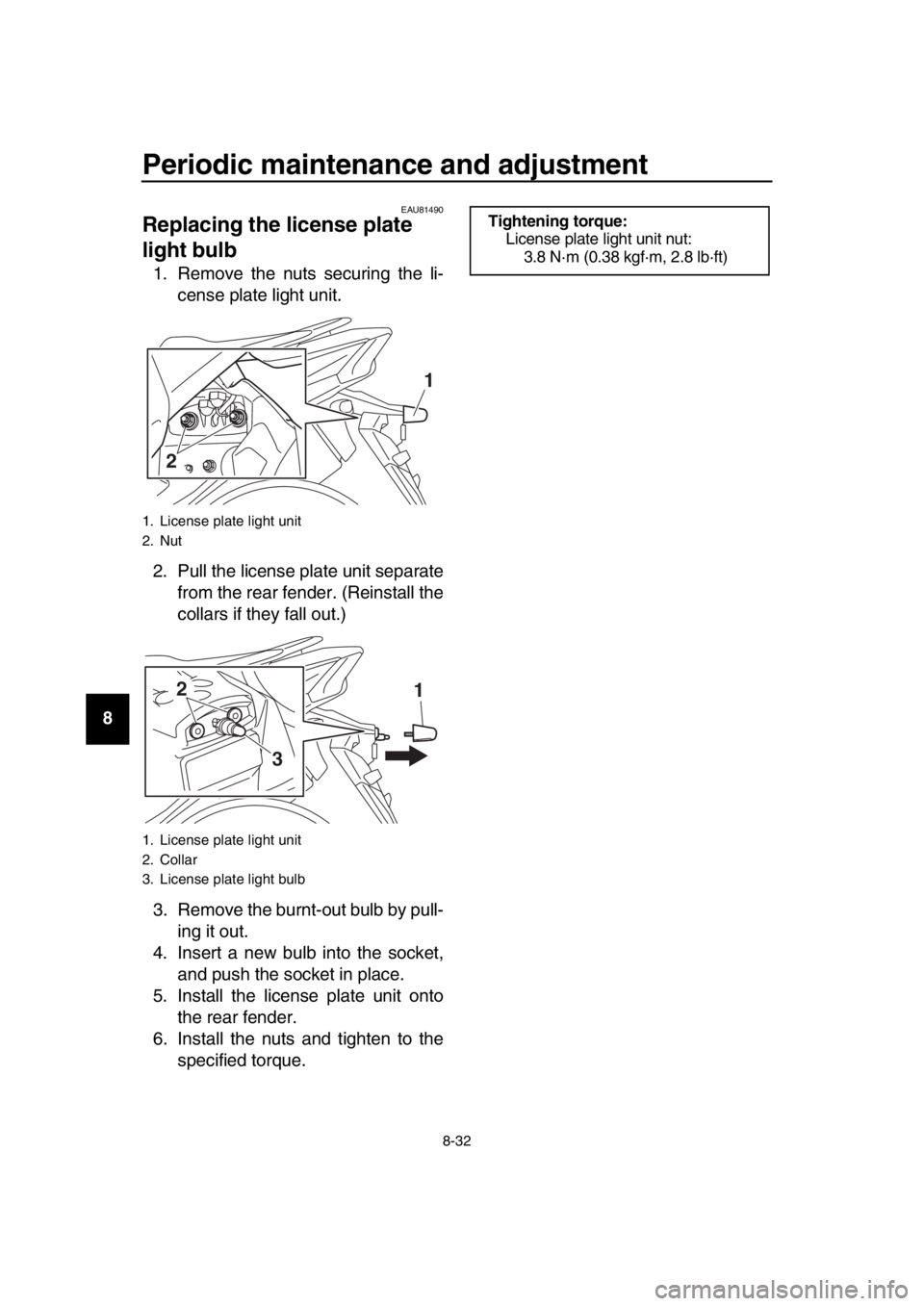
Periodic maintenance and adjustment
8-32
1
2
3
4
5
6
7
8
9
10
11
12
13
14
EAU81490
Replacing the license plate
light bulb
1. Remove the nuts securing the li-
cense plate light unit.
2. Pull the license plate unit separate from the rear fender. (Reinstall the
collars if they fall out.)
3. Remove the burnt-out bulb by pull- ing it out.
4. Insert a new bulb into the socket, and push the socket in place.
5. Install the license plate unit onto the rear fender.
6. Install the nuts and tighten to the specified torque.
1. License plate light unit
2. Nut
1. License plate light unit
2. Collar
3. License plate light bulb
2 1
2
1
3
Tightening torque:
License plate light unit nut:
3.8 N·m (0.38 kgf·m, 2.8 lb·ft)
UBV1E1_1.book 32 ページ 2018年4月27日 金曜日 午後4時41分
Page 105 of 122
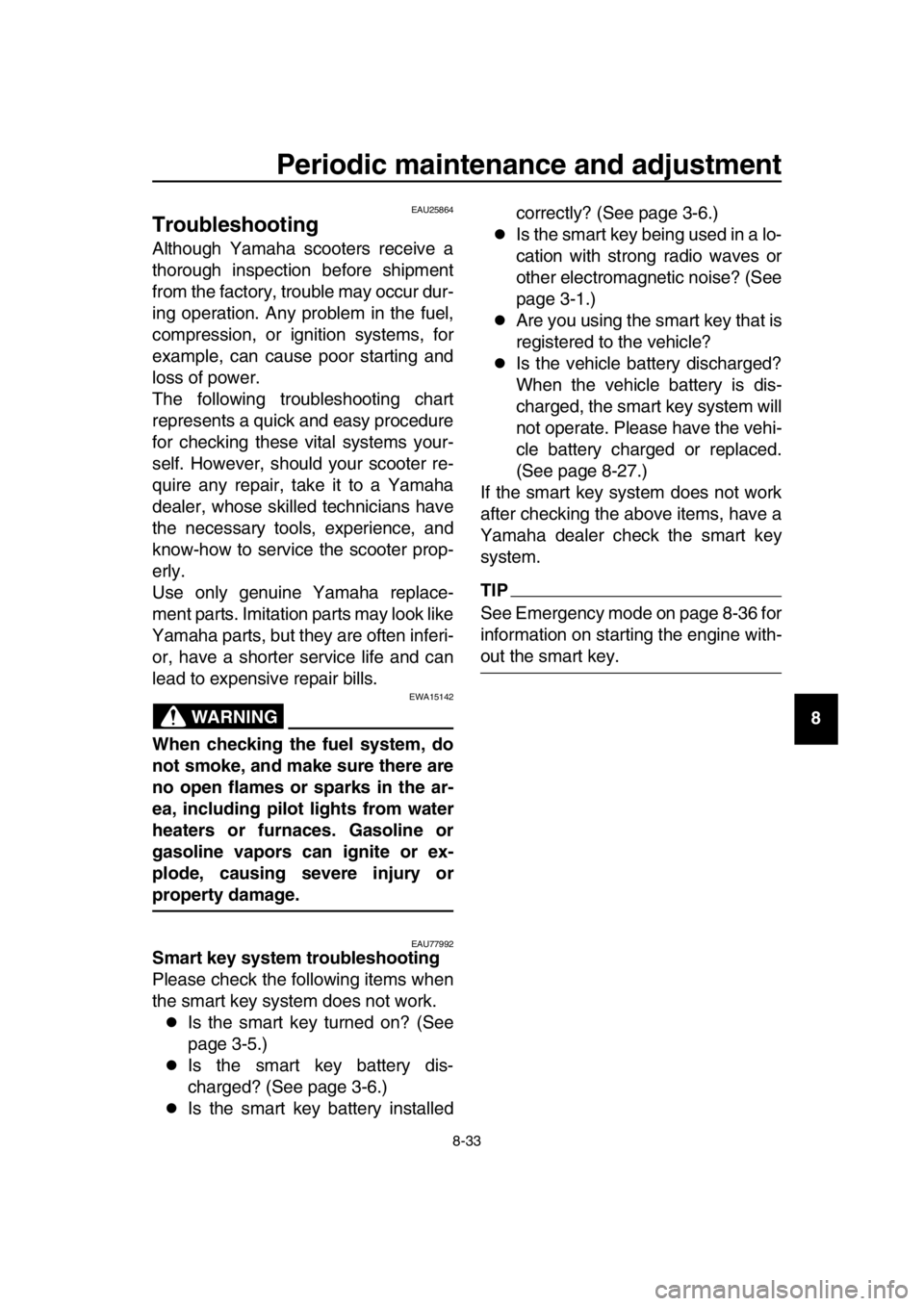
Periodic maintenance and adjustment
8-33
1
2
3
4
5
6
7
8
9
10
11
12
13
14
EAU25864
Troubleshooting
Although Yamaha scooters receive a
thorough inspection before shipment
from the factory, trouble may occur dur-
ing operation. Any problem in the fuel,
compression, or ignition systems, for
example, can cause poor starting and
loss of power.
The following troubleshooting chart
represents a quick and easy procedure
for checking these vital systems your-
self. However, should your scooter re-
quire any repair, take it to a Yamaha
dealer, whose skilled technicians have
the necessary tools, experience, and
know-how to service the scooter prop-
erly.
Use only genuine Yamaha replace-
ment parts. Imitation parts may look like
Yamaha parts, but they are often inferi-
or, have a shorter service life and can
lead to expensive repair bills.
WARNING
EWA15142
When checking the fuel system, do
not smoke, and make sure there are
no open flames or sparks in the ar-
ea, including pilot lights from water
heaters or furnaces. Gasoline or
gasoline vapors can ignite or ex-
plode, causing severe injury or
property damage.
EAU77992Smart key system troubleshooting
Please check the following items when
the smart key system does not work.
Is the smart key turned on? (See
page 3-5.)
Is the smart key battery dis-
charged? (See page 3-6.)
Is the smart key battery installed correctly? (See page 3-6.)
Is the smart key being used in a lo-
cation with strong radio waves or
other electromagnetic noise? (See
page 3-1.)
Are you using the smart key that is
registered to the vehicle?
Is the vehicle battery discharged?
When the vehicle battery is dis-
charged, the smart key system will
not operate. Please have the vehi-
cle battery charged or replaced.
(See page 8-27.)
If the smart key system does not work
after checking the above items, have a
Yamaha dealer check the smart key
system.
TIP
See Emergency mode on page 8-36 for
information on starting the engine with-
out the smart key.
UBV1E1_1.book 33 ページ 2018年4月27日 金曜日 午後4時41分
Page 106 of 122

Periodic maintenance and adjustment
8-34
1
2
3
4
5
6
7
8
9
10
11
12
13
14
EAU63470
Troubleshooting charts
Starting problems or poor engine performance
1. FuelThere is enough fuel.
There is no fuel.
Check the battery.
Supply fuel.
The engine turns over
quickly.
The engine turns over
slowly.
The engine does not
start.
Check the battery.
Wipe off with a dry
cloth and correct the
spark plug gaps, or
replace the spark
plugs.
Check the battery
lead connections, and
have a Yamaha dealer
charge the battery if
necessary.
2. BatteryThe battery is good.
The engine does not
start.
Check the ignition.
3. IgnitionWetOperate the electric
starter.
Dry
There is compression.
There is no
compression.
The engine does not start.
Have a Yamaha dealer check the vehicle.
Have a Yamaha dealer check the vehicle.
The engine does not
start.
Check the
compression.Have a Yamaha
dealer check the
vehicle.
Remove the spark
plugs and check
the electrodes.
Operate the electric
starter.
Operate the electric
starter.
Check the fuel level
in the fuel tank.
4. Compression
UBV1E1_1.book 34 ページ 2018年4月27日 金曜日 午後4時41分
Page 107 of 122
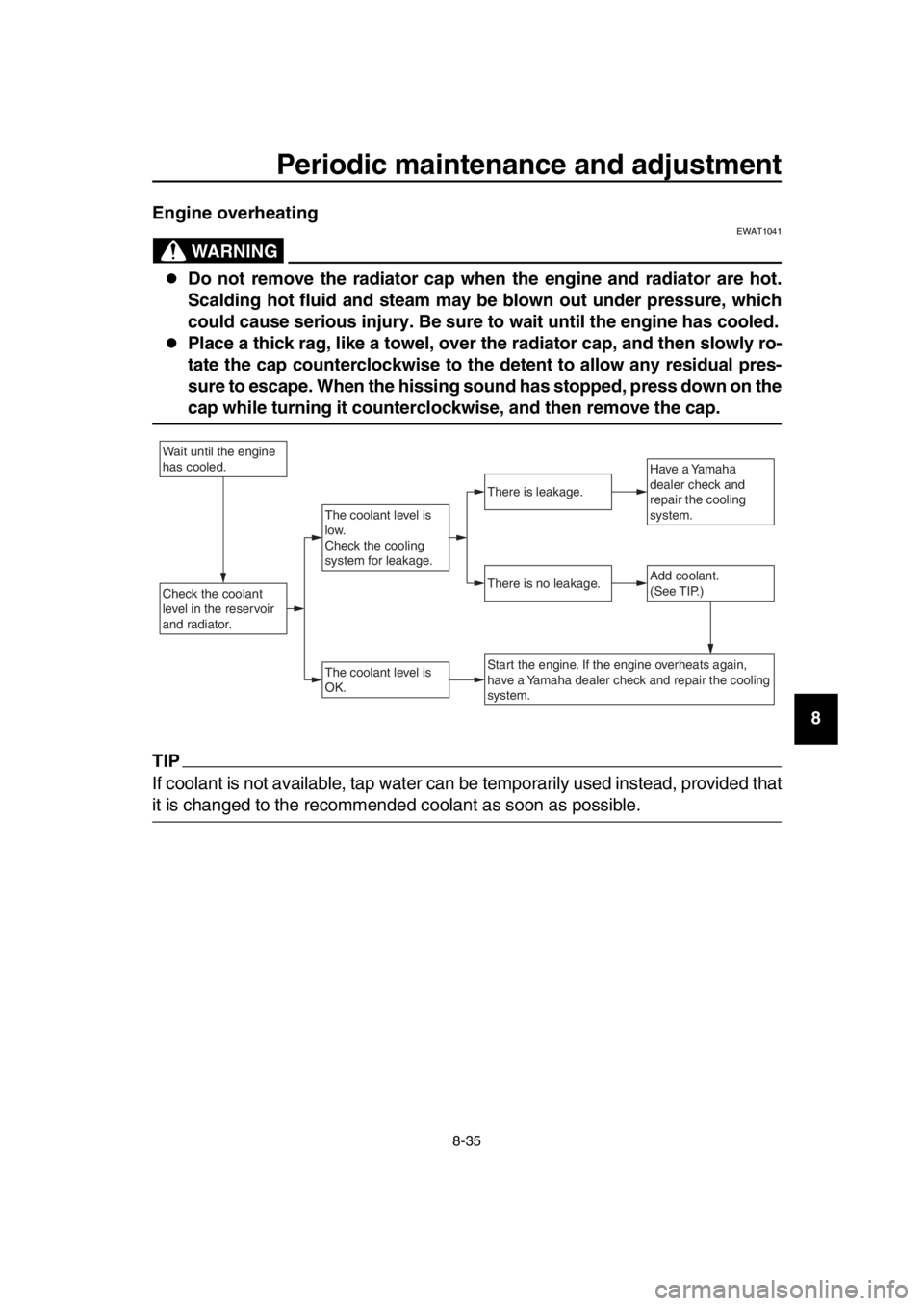
Periodic maintenance and adjustment
8-35
1
2
3
4
5
6
7
8
9
10
11
12
13
14
Engine overheating
WARNING
EWAT1041
Do not remove the radiator cap when the engine and radiator are hot.
Scalding hot fluid and steam may be blown out under pressure, which
could cause serious injury. Be sure to wait until the engine has cooled.
Place a thick rag, like a towel, over the radiator cap, and then slowly ro-
tate the cap counterclockwise to the detent to allow any residual pres-
sure to escape. When the hissing sound has stopped, press down on the
cap while turning it counterclockwise, and then remove the cap.
TIP
If coolant is not available, tap water can be temporarily used instead, provided that
it is changed to the recommended
coolant as soon as possible.
Wait until the engine
has cooled.
Check the coolant
level in the reservoir
and radiator.Add coolant.
(See TIP.)
The coolant level is
OK.
There is no leakage.
There is leakage.
The coolant level is
low.
Check the cooling
system for leakage.
Have a Yamaha
dealer check and
repair the cooling
system.
Start the engine. If the engine overheats again,
have a Yamaha dealer check and repair the cooling
system.
UBV1E1_1.book 35 ページ 2018年4月27日 金曜日 午後4時41分
Page 108 of 122

Periodic maintenance and adjustment
8-36
1
2
3
4
5
6
7
8
9
10
11
12
13
14
EAU77372
Emergency mode
When the smart key is lost, damaged,
or its battery has discharged, the vehi-
cle can still be turned on and the engine
started. You will need a mechanical key
and the smart key system identification
number. To operate the vehicle in
emergency mode, carry out the follow-
ing steps.
TIP
Emergency mode operation will be
cancelled if the respective steps are not
carried out within the time set for each
operation or if the “OFF/LOCK” switch
is pushed. 1. Stop the vehicle in a safe place.
2. Unlock the seat by inserting the mechanical key into the lock locat-
ed right side of body and turn it
counter clockwise.
3. Open the seat and check that the trunk light comes on.
4. Push the “ON/ ” switch once.
5. Without completely shutting the seat, raise and lower it three times
within 10 seconds.
TIP
Use the rear storage compartment light
as a guide when raising and lowering
the seat. The smart key system indicator
light on the speedometer will come
on for three seconds to indicate
the transition to emergency mode.
6. After the smart key system indica- tor light goes off, use the “ / ”
switch to enter the identification
number.
7. Inputting the identification number is done by counting the number of
flashes of the smart key system in-
dicator light.
For example, if the identification
number is 123456:
Push and hold the “ / ” switch.
The smart key system indicator
light will start to flash.
1. Smart key system indicator light “ ”
1. Identification number
1
12345 6
1
UBV1E1_1.book 36 ページ 2018年4月27日 金曜日 午後4時41分
Page 109 of 122
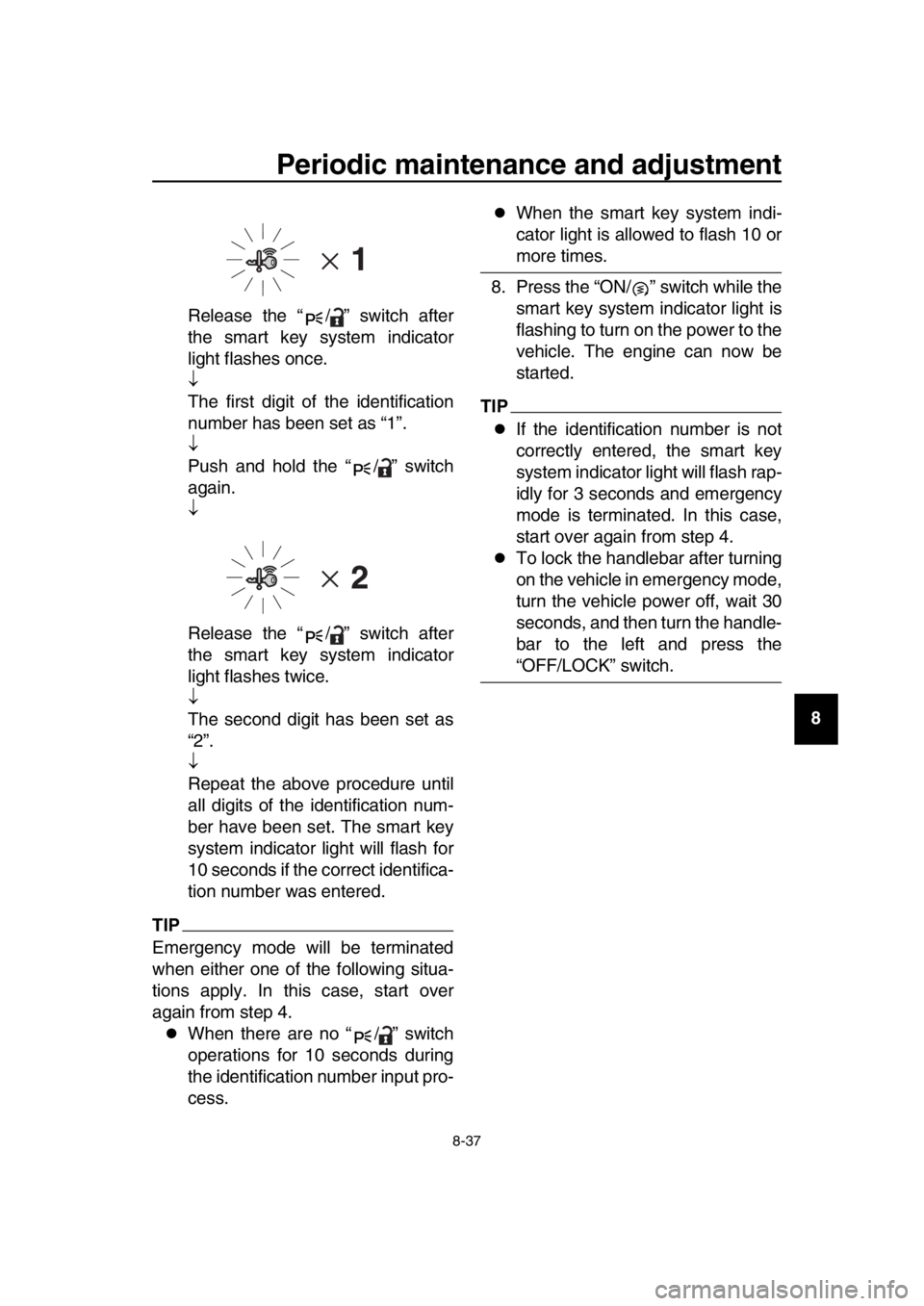
Periodic maintenance and adjustment
8-37
1
2
3
4
5
6
7
8
9
10
11
12
13
14
Release the “ / ” switch after
the smart key system indicator
light flashes once.
The first digit of the identification
number has been set as “1”.
Push and hold the “ / ” switch
again.
Release the “ / ” switch after
the smart key system indicator
light flashes twice.
The second digit has been set as
“2”.
Repeat the above procedure until
all digits of the identification num-
ber have been set. The smart key
system indicator light will flash for
10 seconds if the correct identifica-
tion number was entered.
TIP
Emergency mode will be terminated
when either one of the following situa-
tions apply. In this case, start over
again from step 4.
When there are no “ / ” switch
operations for 10 seconds during
the identification number input pro-
cess.
When the smart key system indi-
cator light is allowed to flash 10 or
more times.
8. Press the “ON/ ” switch while the smart key system indicator light is
flashing to turn on the power to the
vehicle. The engine can now be
started.
TIP
If the identification number is not
correctly entered, the smart key
system indicator light will flash rap-
idly for 3 seconds and emergency
mode is terminated. In this case,
start over again from step 4.
To lock the handlebar after turning
on the vehicle in emergency mode,
turn the vehicle power off, wait 30
seconds, and then turn the handle-
bar to the left and press the
“OFF/LOCK” switch.
UBV1E1_1.book 37 ページ 2018年4月27日 金曜日 午後4時41分
Page 110 of 122
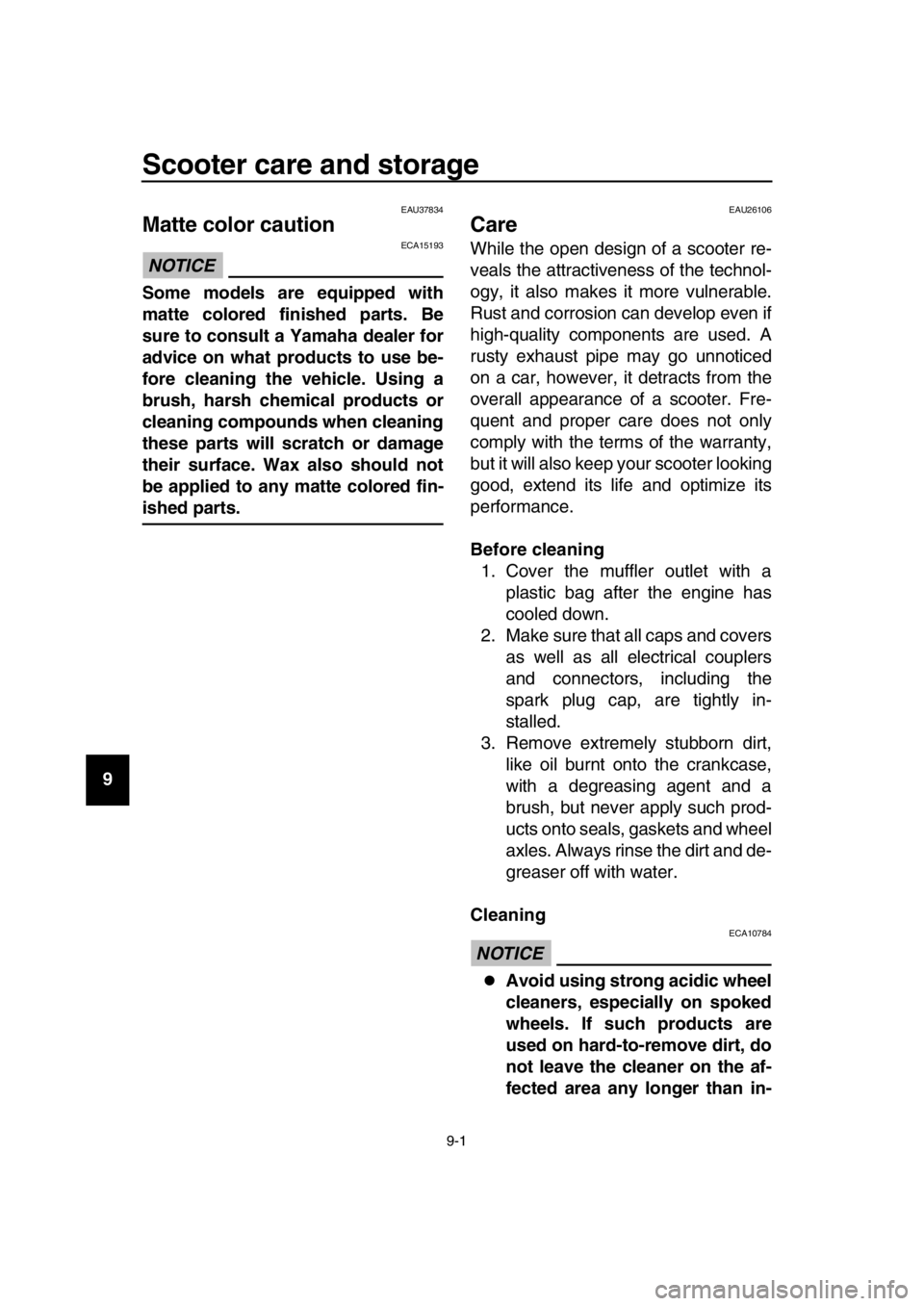
9-1
1
2
3
4
5
6
7
8
9
10
11
12
13
14
Scooter care and storage
EAU37834
Matte color caution
NOTICE
ECA15193
Some models are equipped with
matte colored finished parts. Be
sure to consult a Yamaha dealer for
advice on what products to use be-
fore cleaning the vehicle. Using a
brush, harsh chemical products or
cleaning compounds when cleaning
these parts will scratch or damage
their surface. Wax also should not
be applied to any matte colored fin-
ished parts.
EAU26106
Care
While the open design of a scooter re-
veals the attractiveness of the technol-
ogy, it also makes it more vulnerable.
Rust and corrosion can develop even if
high-quality components are used. A
rusty exhaust pipe may go unnoticed
on a car, however, it detracts from the
overall appearance of a scooter. Fre-
quent and proper care does not only
comply with the terms of the warranty,
but it will also keep your scooter looking
good, extend its life and optimize its
performance.
Before cleaning 1. Cover the muffler outlet with a plastic bag after the engine has
cooled down.
2. Make sure that all caps and covers as well as all electrical couplers
and connectors, including the
spark plug cap, are tightly in-
stalled.
3. Remove extremely stubborn dirt, like oil burnt onto the crankcase,
with a degreasing agent and a
brush, but never apply such prod-
ucts onto seals, gaskets and wheel
axles. Always rinse the dirt and de-
greaser off with water.
Cleaning
NOTICE
ECA10784
Avoid using strong acidic wheel
cleaners, especially on spoked
wheels. If such products are
used on hard-to-remove dirt, do
not leave the cleaner on the af-
fected area any longer than in-
UBV1E1_1.book 1 ページ 2018年4月27日 金曜日 午後4時41分